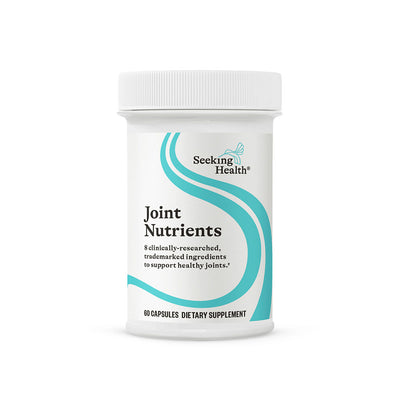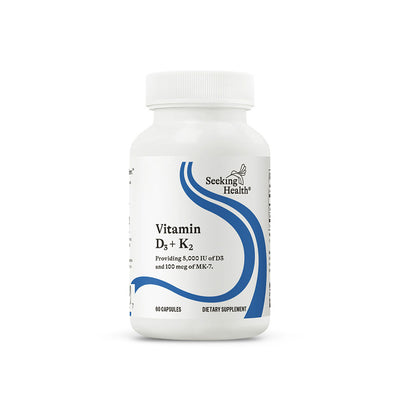Many people blame genetics for their health struggles. But the truth is, we actually have a say in things. Even if you were born with “dirty genes,” you have the power to clean them up. Having a genetic mutation or variation doesn’t doom you to a life of illness. In fact, you can use the power of epigenetics to turn ‘off’ problematic genes and turn ‘on’ beneficial ones.
Dr. Ben Lynch is the founder of Seeking Health and the author of the national bestseller Dirty Genes: A Breakthrough Program to Treat the Root Cause of Illness. His research focus on epigenetics and nutrigenomics is rooted in a passion for helping others optimize their genetic function. Dr. Lynch frequently says that “Your genes are not your destiny.”
You have more than 30,000 genes in your body. But don’t worry—you don’t have to figure out how to clean every single one of them. While each serves a distinct purpose, Dr. Lynch has identified seven that have the most far-reaching effects on your health. He calls these your “Super Seven Genes.” They affect everything from your digestion, to your sleep, mood, and beyond.
You can dramatically change the course of your health. It just takes an understanding of how these seven genes work, what they need, and whether yours are acting clean or dirty. In this blog, we will introduce you to the Super Seven genes, as described in Dr. Lynch’s groundbreaking book, Dirty Genes.
Click HERE to Download our FREE Super Seven eBookGenetic Mutations are Dirty Genes
You inherit genes from your parents. You can inherit, and be born with, certain genetic mutations (also called variants or SNPs—which are pronounced “snips”). You can also experience changes to your genetic function based on your environment: lack of nutrients, stress, poor sleep, chemical exposure, and much more. Thus, you can be born with “dirty genes” (Dr. Lynch calls these “born dirty genes”), or your genes can be acting dirty due to lifestyle factors. In either scenario, the gene is working less than optimally. This can impact your health on a multitude of levels if left unchecked.
The good news is that you can change the way your genes work. You do this by cleaning your genes with the Soak and Scrub. Some dirty genes are hard to get clean. Not the Super Seven. They can be easily cleaned up through dietary and lifestyle changes. The challenging part is knowing which of your Super Seven Genes are dirty and need support. Each of these genes has slightly different requirements to be optimized. Dr. Ben Lynch designed an assessment to help you determine which of your Super Seven Genes are acting dirty. You can take the full assessment in his book, Dirty Genes.
Meet Your Super Seven Genes

Let’s start by meeting each of your Super Seven Genes. Then we will dive into more detail about each one. While you have thousands of genes in your body, these seven are thought to have the most far-reaching effects on your health and wellness.
- MTHFR (the mother of all genes): This gene initiates your body’s ability to perform the process of methylation. It plays crucial roles in maintaining healthy homocysteine levels, natural inflammatory processes, brain chemistry, energy production, immune function, detoxification, cellular repair, and much more. Dirty MTHFR genes are probably the most common of all the SNPs (single nucleotide polymorphisms). A dirty MTHFR gene can underlie nervousness, brain fog, chemical sensitivity, low mood, elevated homocysteine levels, irritability, heavy periods or cramps, hypothyroidism, and infertility.
- COMT (mood/hormones): This gene affects metabolism of the major neurotransmitters that influence your mood, estrogen and energy levels, ability to calm down, sleep, and focus. A dirty COMT gene can leave you moody, stressed, distracted, and struggling to get a good night's sleep.
- DAO (sensitivity): This gene impacts how sensitive you are to the environment, particularly food and toxins. It impacts your response to histamine, which in turn can influence how sensitive or allergic you are to various foods. A dirty DAO gene can create itchy skin, hives, runny nose, leaky gut, food sensitivities, SIBO, migraines, nausea/indigestion, pregnancy complications, and irritability.
- MAOA (brain/mental health): This gene affects your relationship to dopamine, norepinephrine, and serotonin, thus governing your mood, energy, sleep, and sugar cravings. A dirty MAOA gene can leave you moody, craving carbs and sugar, and struggling with sleep.
- GST/GPX (detoxification): These two genes have a strong influence on the body’s ability to collect chemicals and heavy metals and get rid of them. Dirty GST/GPX genes can lead to chemical hypersensitivity, inflammation, excess weight, fatigue, irritability, and early graying.
- NOS3 (heart issues): This gene can impact the production of nitric oxide, healthy blood flow, and overall cardiovascular wellness. A dirty NOS3 gene disrupts your ability to make enough nitric oxide, which is a major factor in cardiovascular health.
- PEMT (liver/cells): This gene impacts your body’s ability to make phosphatidylcholine, a vital compound that is needed for cell membranes, brain development, bile flow, liver health, and the health of your nerves, brains, and muscles. A dirty PEMT gene can disrupt your ability to make enough phosphatidylcholine (PC).

Your genes don’t exist in a vacuum. How one works can affect many others.
When one or more become dirty, it can lead to issues ranging from pesky symptoms to chronic disorders and many things in between.
Some dirty genes are hard to get clean. Not these seven. The good news is that they can be easily cleaned up through dietary and lifestyle changes.
The challenging part is knowing which of your Super Seven Genes are dirty and need support. Each of these genes has slightly different requirements to be optimized.
Now that you’ve met the Super Seven Genes, it’s time to find out which ones might be causing your headaches… literally!
Take the Dirty Genes assessment in Dr. Lynch’s book, Dirty Genes.
Next, let’s dive into each of the Super Seven genes a little deeper. As you read these descriptions, take note as to which of your Super Seven Genes could use extra support.
After that, we’ll cover the Dirty Genes protocol and why you’re never stuck at the mercy of finicky genes—there’s always something you can do to improve your epigenetic well-being!
MTHFR
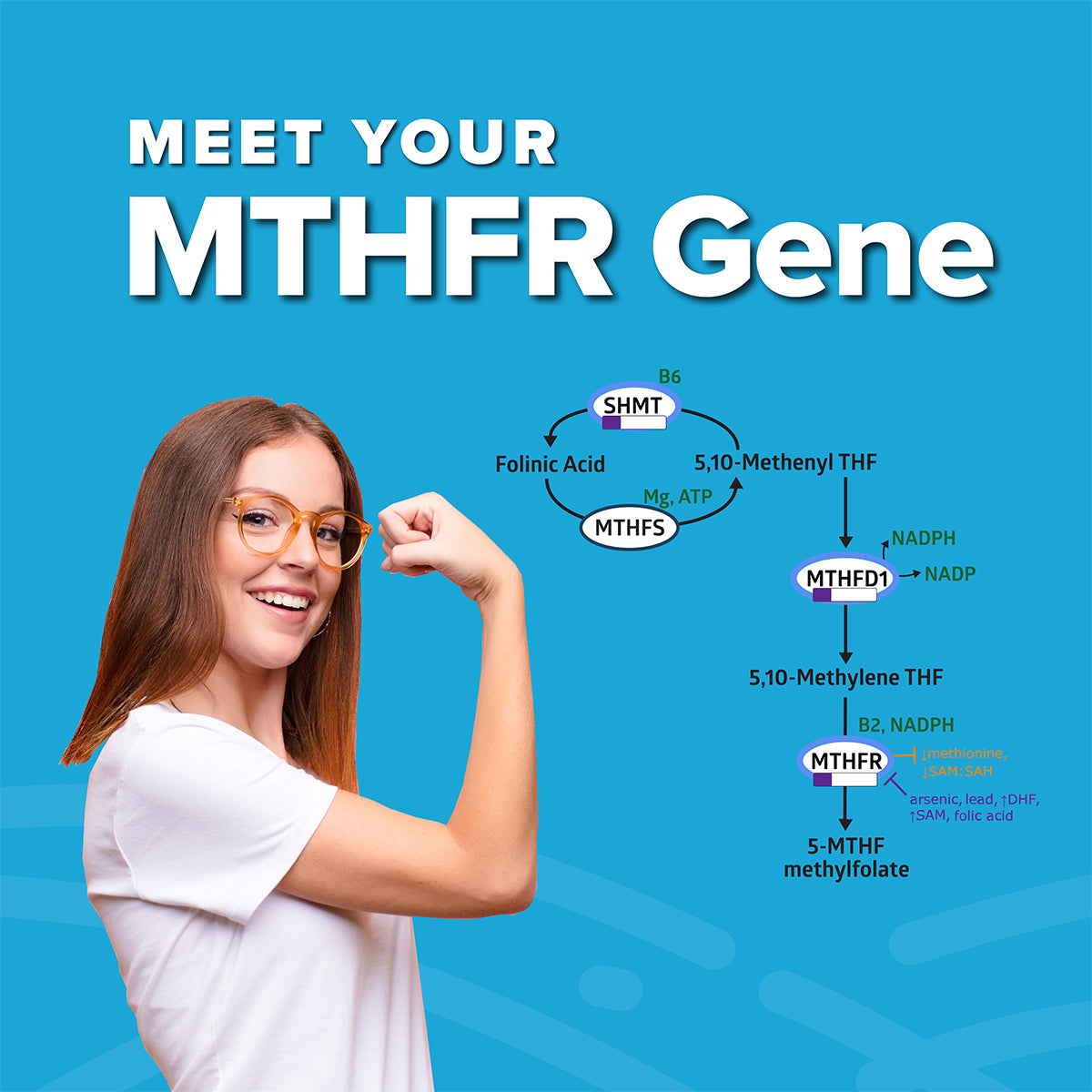
The most well-known of the Super Seven, MTHFR is a gene that makes an enzyme of the same name: methylenetetrahydrofolate reductase. This enzyme converts folate in a multi-step process that is vital for the conversion of homocysteine into methionine. When MTHFR is dirty, this process becomes less efficient, leaving the body with too much homocysteine and short on methionine, which is needed for making proteins and compounds in the body.
The MTHFR gene is also central to the process of methylation. This crucial biochemical reaction enables more than 200 of your body’s vital processes, including genetic expression (whether or not your genes are turned “on” or “off”).
Up to 60% of the population is thought to have a variation, or genetic mutation in their MTHFR gene. Your MTHFR gene can be born dirty (i.e. genetic mutation in your MTHFR gene), or it can become dirty from poor lifestyle habits. A dirty MTHFR gene can slow down the production or activity of your MTHFR enzymes which convert folate into its active form. A dysfunctional MTHFR gene can result in a lack of methylation or folate in your body, which in turn can impact other aspects of health.
However, knowing that your MTHFR gene was “born dirty” is empowering information. You might choose to supplement with the bioactive form of folate, L-methylfolate, which bypasses the MTHFR enzyme to support healthy methylation in your body, despite an MTHFR mutation.†
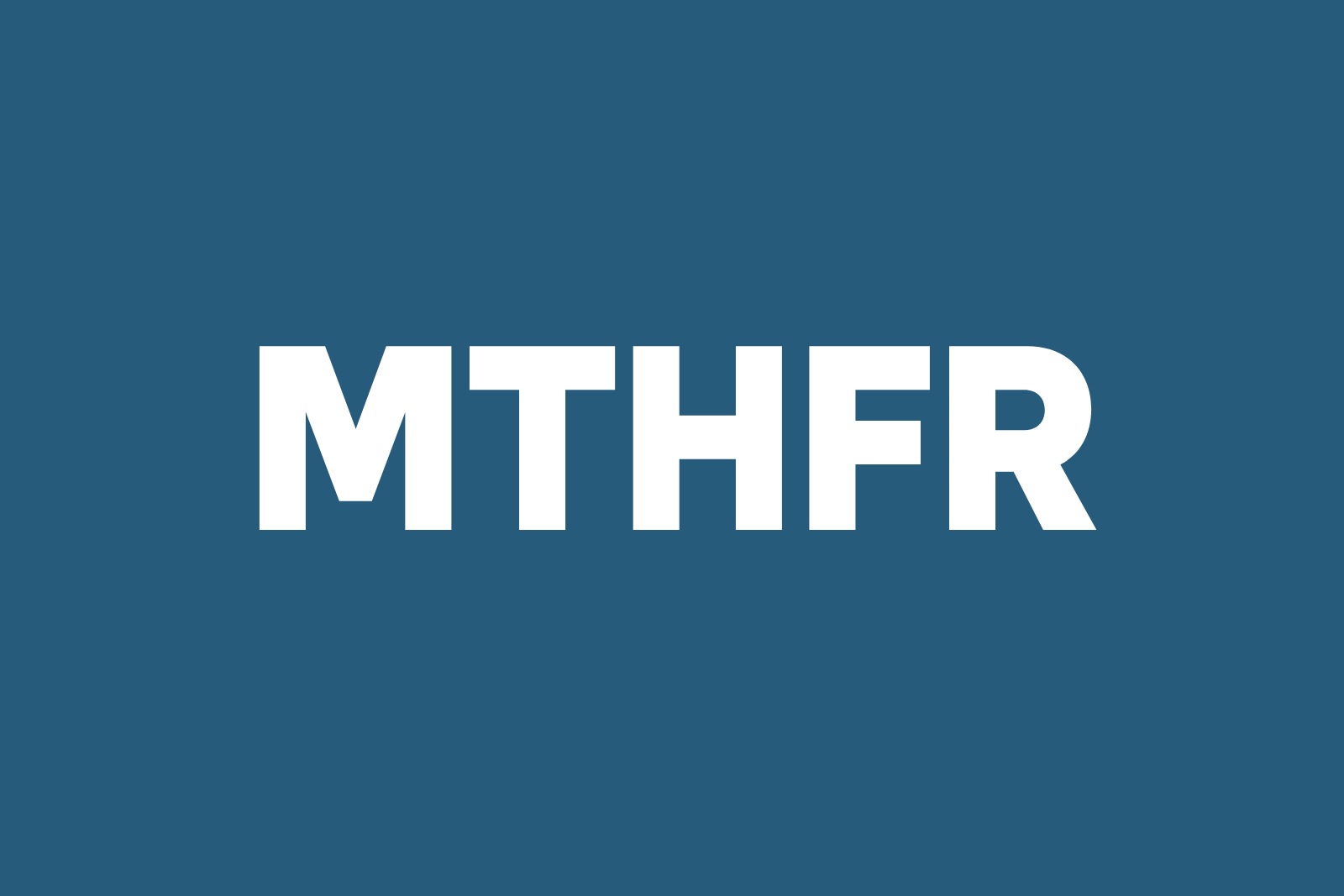
Key characteristics of the MTHFR gene
- Initiates methylation cycle, providing methyl groups to 200+ functions in the body
- Crucial for antioxidants and detoxification
- Required for energy production
- Influences genetic expression (epigenetics)
- Necessary for normal immune system function
- Supports normal homocysteine levels
- Necessary for normal inflammatory responses in the body
Signs your MTHFR gene is dirty†
- Frequent headaches
- Brain fog
- Sweating profusely during exercise
- Eating folic acid (or fortified foods)
- Experiencing low or tense moods frequently
- Irritability
- Cold hands and feet
- Low white blood cell count
- Strong side effects from nitrous oxide
- Heavy menstrual periods, sometimes with clots
- High homocysteine levels (above 12)
- Poor alcohol tolerance
How does the MTHFR gene get dirty?†
- Too much folic acid, too little methylfolate
- Insufficient active forms of vitamin B12
- Not enough vitamin B2 (riboflavin)
- Vegan or vegetarian diet (not enough meat, eggs, seafood)
- Antacid use
- H. pylori infection (or ulcers)
- Pernicious anemia
- Exposure to industrial chemicals or solvents
- Physical or psychological overwhelm
- Low thyroid hormones
- Smoking or secondhand smoke exposure
- Excessive alcohol intake
- Other dirty genes
- Disruption in normal inflammatory responses
- High levels of free radicals
- Heavy metal exposure
- Candida
- Small intestinal bacterial overgrowth (SIBO)
- Infection, acute or chronic
- Nutrient deficiency or malabsorption
- Leaky gut or Celiac disease
COMT

The COMT gene also makes an enzyme of the same name: catechol-O-methyltransferase. This enzyme is produced by nerve cells in the brain, as well as in the liver, kidneys, and the blood, where it helps to regulate neurotransmitters and hormones. (2)
COMT determines the body’s ability to process certain compounds, hormones, and neurotransmitters. It helps the body to metabolize or make use of estrogen, a crucial hormone in men and women.
Compounds known as catechols—which are found in tea, spices, coffee, and chocolate—are broken down and used in response to COMT, too.
It also influences how dopamine, norepinephrine, and epinephrine are used in the body. Dopamine is necessary for a balanced state of mind, and low levels are tied to addictions, thrill, and the surge of any other activity that feels high-stakes or exciting. Norepinephrine and epinephrine (also known as noradrenaline and adrenaline) are the body’s neurotransmitters for adapting to and handling overwhelm and chaos in life. COMT influences not only how quickly those neurotransmitters are available for use, but also how effectively you can clear them when they’re no longer needed.
COMT is a gene that can either work too quickly or too slowly when it gets dirty, with differing results for epigenetic health. Some people's COMT genes are too slow. Others are too fast. Both states are considered “dirty”. You want your COMT to be just right, nice and balanced.
Slow COMT genes metabolize too slowly. This allows estrogen, dopamine, norepinephrine, epinephrine, and catechols to linger too long in your body.
Fast COMT genes are the opposite: these chemicals are cleared from your body too quickly.
5 signs that your COMT is slow
- Estrogen issues (menstrual issues, fibroids, etc.)
- Difficulty relaxing
- Irritable
- Sleep issues
- Workaholic
5 signs that your COMT is fast
- Hard to focus
- Low energy
- Reliant on stimulants
- Lack confidence
- Menopause/perimenopause challenges
But it’s not all bad news. A slow COMT has some positives, too. They tend to be confident, productive, and enthusiastic about life. And fast COMTs are able to relax and have higher stress tolerance.

Key characteristics of fast COMT gene
- Clears catechols, neurotransmitters, and estrogen too fast, resulting in shortages
Key characteristics of slow COMT gene
- Difficulty clearing catechols, estrogen, and neurotransmitters, resulting in excesses and a backup in how these compounds are used
Signs your fast COMT gene is dirty
- Poor attention and focus
- Poorly detailed memory and forgetfulness
- Addictive or compulsive personality (shopping, gambling, alcohol, social media, etc.)
- “Need” coffee/caffeine, chocolate, tea
- Low mood and pessimism
- Poor motivation and drive; low energy
- Carbs boost mood in the short-term but decrease mood later
- Struggle relating to hormone changes like postpartum, perimenopause, or menopause
Signs your slow COMT gene is dirty
- Frequent headaches
- Difficulty falling asleep and other sleep challenges
- Feeling restless or worried
- Irritability
- PMS, fibroids, and other estrogen-related disorders
- Low pain tolerance or chronic pain
- Sensitivity to caffeine, chocolate, and/or green tea
- Trouble relaxing or workaholic tendencies
How does fast COMT get dirty?
- Too much SAMe
- Too much homocysteine
- Not enough folate, B12, or magnesium
- Dirty MTHFR
How does slow COMT get dirty?
- Low levels of SAMe
- Imbalanced homocysteine levels
- Too much coffee, caffeine, chocolate, or black/green tea
- Excessive amounts of life overload (tense job, lifestyle, relationships, etc.)
- Overweight or obesity
- Diet too high in animal fats
- Excessive exposure to xenoestrogens (plastic, cosmetics, chemicals, cleaners, etc.)
- Not enough folate, B12, or magnesium
- Dirty MTHFR
DAO
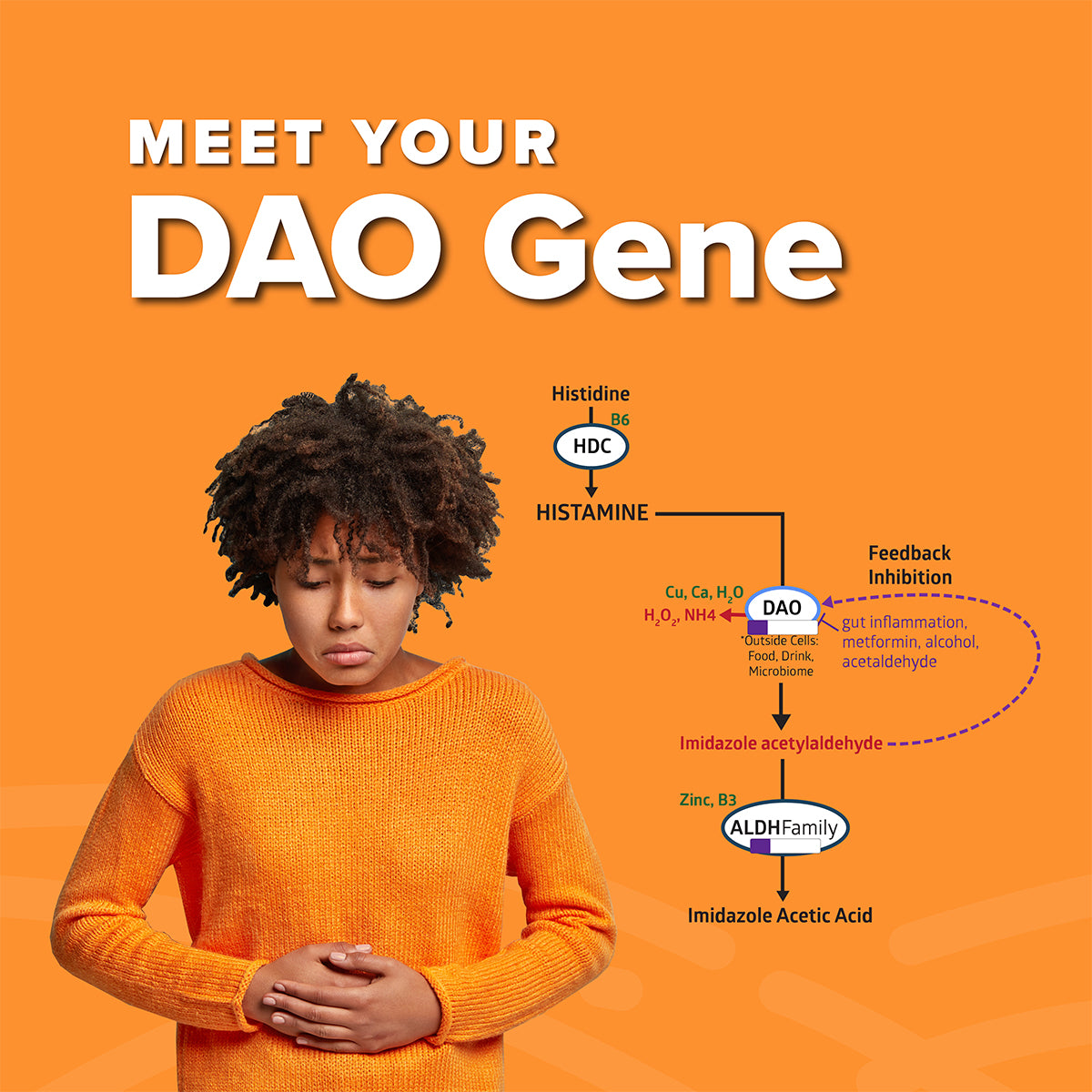
DAO is another gene that also produces an enzyme of the same name. It stands for diamine oxidase. (3) The DAO enzyme is found in almost all of the organs, but in highest quantities in the small intestine, kidneys, colon, prostate, and placenta.
The DAO gene produces DAO enzymes. Your DAO enzymes process an important compound called histamine.
Histamine is a natural chemical in your body released during allergic and inflammatory reactions. Some foods contain histamine, like aged cheeses, fermented foods, cured meats, alcohol, and many others. Certain gut bacteria and strains of probiotics, like Lactobacillus, also produce histamine.
We need some histamine. But having too much can cause the immune system to overreact, leading to autoimmune and allergic symptoms. This is known as histamine intolerance. The DAO enzyme is responsible for breaking down histamine. Regular histamine clearance is needed for proper histamine control and balance.
- Needed for histamine balance
- Found in all organs, but highest in small intestine
Signs your DAO gene is dirty
- Histamine problems
- Food sensitivity, especially to citrus, seafood, or reheated foods
- Intolerant of red wine or alcohol
- Frequent nose bleeds
- Headaches or migraines
- Irritable bowel issues, such as diarrhea, with no known cause
- Leaky gut syndrome
- Health is better during pregnancy (including ability to digest food)
- Skin stays red for longer than normal after getting scratched
- Sweaty feet
- Frequently feel itchy
- Heartburn or acid reflux
- Frequently need antihistamines
- Near-constant congestion or runny nose
- Sleep problems
- Low blood pressure
- Joint pain
- Frequently experience worse-than-normal side effects from medications
- Sensitivity to dust mites
How does DAO get dirty?
- Methylation problems
- Pathogens
- Food allergies
- Leaky gut
- Digestion problems
- High-histamine diet
- SIBO
- Candida
- Medications (antibiotics, antacids, metformin, etc.)
- Highly acidic diet or lots of processed foods
- Too much protein
- Gluten
- Eating food you’re sensitive to
- Medical treatments
- Mental or emotional overwhelm
MAOA
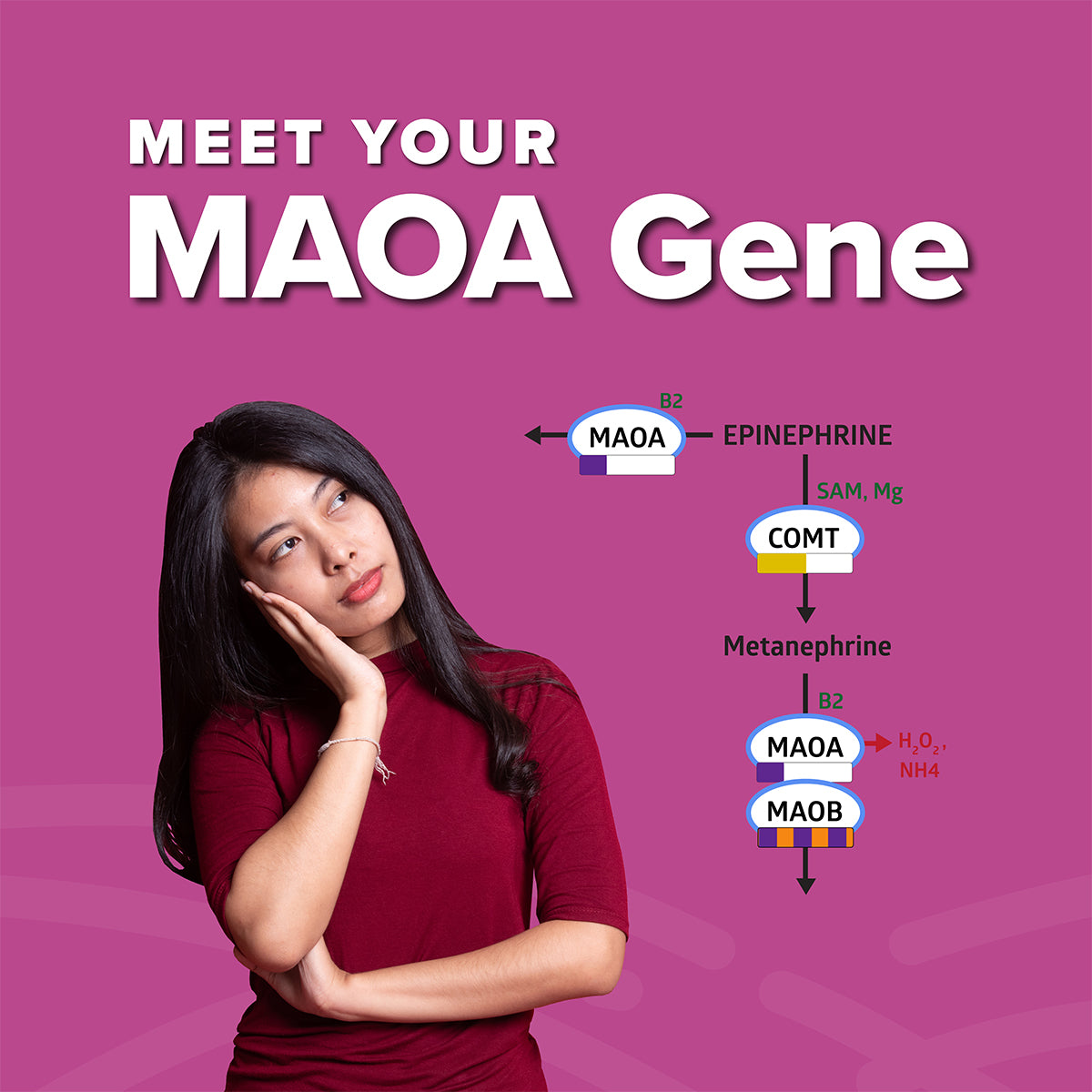
MAOA stands for monoamine oxidase A, which is responsible for the process of making an enzyme of the same name. (4) The enzyme helps the body to handle two neurotransmitters: norepinephrine and dopamine. These neurotransmitters help the body cope with fight-or-flight needs by providing a jolt of energy and the ability to handle conflict. MAOA is also necessary for using serotonin, the neurotransmitter that helps provide feelings of calm, balance, and optimism.
Your MAOA gene affects the way you metabolize:
- Dopamine and Norepinephrine—Two important neurotransmitters that help you engage your stress response
- Serotonin—The key neurotransmitter that enables you to feel calm and optimistic
A dirty MAOA sets you up for tremendous mood swings. This is especially true if you were also born with a dirty MTHFR and/or COMT.
MAOA is another gene that can either function too quickly or too slowly. Some people's MAOA genes are too slow. Others are too fast. Both states are considered “dirty”. You want your MAOA to be just right, nice and balanced.
Slow MAOAgenes metabolize too slowly. This can cause an excess of these neurotransmitters to linger in your body.
Fast MAOA genes are the opposite: they are cleared from your body too quickly. As a result, you might experience a shortage of these vital neurotransmitters.

Key characteristics of FAST MAOA gene
- Eliminates norepinephrine, dopamine, and serotonin too quickly
Key characteristics of SLOW MAOA gene
- Eliminates norepinephrine, dopamine, and serotonin too slowly
Signs your MAOA gene is too FAST
- Fall asleep fast but don’t stay asleep
- Mood swings
- Feelings of sadness or low mood
- Lack of motivation or focus
- Feel a boost from eating chocolate
- Addictive behaviors: smoking, alcohol, etc.
- Carb and sugar cravings
- Carbs boost mood but don’t increase focus
- Fatigue
- Early graying hair or hair that turns white
Signs your MAOA gene is too SLOW
- Hard time falling asleep, but once there can sleep through the night
- Lots of overwhelm or worrying
- Startle easily
- Headaches or migraines
- Hard to unwind after annoyance or irritation
- Chocolate, cheese, wine, or indulgent foods cause feelings of blah or bloating
- Mood swings and irritability
How does a FAST MAOA get dirty?
- Eating too many carbs
- Not enough tryptophan
- Too much vitamin B2
- Not enough glutathione
- Chronic feelings of overwhelm or isolation
- Blood sugar imbalance
- Candida
- SIBO
- Leaky gut
- Poor dietary choices
- Obesity
- Autoimmunity
How does a SLOW MAOA get dirty?
- Too much tryptophan
- Not enough vitamin B2
- Not enough glutathione
- Chronic overwhelm
- Blood sugar imbalance
- Candida
- SIBO
- Leaky gut
- Poor dietary choices
- Obesity
- Autoimmunity
But it's not all bad news. A slow MAOA has some positive attributes, too! They tend to be alert, focused, and productive. And fast MAOA's are generally more relaxed and easygoing.
GST/GPX

GST and GPX are actually two separate genes, but they work so closely together that Dr. Ben Lynch considers them a unit. These two genes get dirty in similar ways. Likewise, you keep them clean in similar ways. Both are absolutely vital for detoxification and clearing problematic compounds from your body.
Your GST/GPX genes help your body to use glutathione, which acts as your body’s master antioxidant to support detoxification.
Glutathione S-transferase (GST) is a gene that makes an enzyme of the same name. Your GST gene helps your body attach glutathione to harmful toxins. This is how glutathione neutralizes toxins so you can pee them out. If not eliminated, these harmful chemicals can damage your DNA, cells, and proteins.
Glutathione peroxidase (GPX) is a gene that makes an enzyme, also of the same name. The GPX enzyme transfers glutathione to hydrogen peroxide. Via this reaction, hydrogen peroxide is converted to water that can be eliminated via urine. Hydrogen peroxide is produced naturally in the body as a result of various biochemical processes, and if not eliminated, can cause damage to cells and DNA that can lead to health problems. Excess hydrogen peroxide in your system also disrupts your methylation cycle, so it's important to remove it regularly!
When your GST gene is dirty, your body is unable to attach glutathione to toxins. This is an especially big problem if you're faced with a lot of chemical exposure.
When your GPX gene is dirty, you can't efficiently use glutathione to convert hydrogen peroxide to water. This can disrupt your methylation cycle and more.

Key characteristics of GST/GPX genes
- Needed to clear xenobiotics and hydrogen peroxide, toxins that can damage DNA
- Required for glutathione function
5 signs that your GST gene is dirty
- Chemical hypersensitivity
- Inflammation
- High blood pressure
- Overweight/obese
- Allergy symptoms like congestion, runny nose, watery eyes, coughing, sneezing, migraine, rashes, hives, nervousness, brain fog
5 signs that your GPX gene is dirty
- Early graying or white hair
- Erratic moods
- Chronic fatigue
- Memory problems
- Irritability or aggression
How do GST/GPX get dirty?
- Chemical or toxic exposure to solvents, heavy metals, plastics, etc.
- Chronic physical, mental, and/or emotional overwhelm
- MTHFR and methylation problems
- Low levels of vitamin B2
- Low levels of selenium
- Low levels of cysteine
But it's not all bad news. A dirty GST or GPX has some positive attributes, too! Your body will let you know early on about chemical exposures or excess hydrogen peroxide, which motivates you to remedy the situation.
NOS3
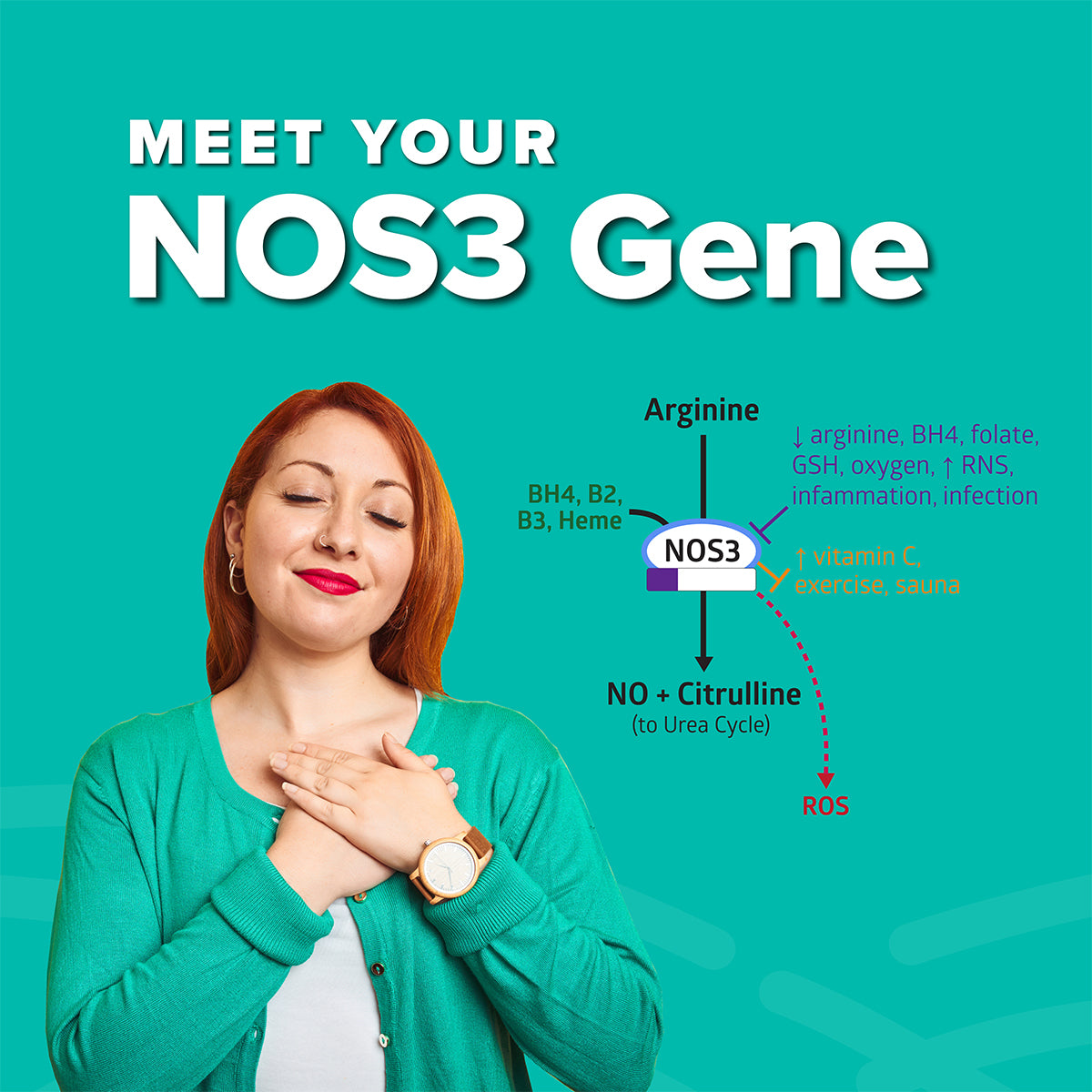
NOS3 stands for nitric oxide synthase 3. Your NOS3 gene helps your body produce nitric oxide (NO). Nitric oxide's most important function is vasodilation, meaning, it relaxes your blood vessels, causing them to widen and increase circulation. This effectively raises blood supply while lowering blood pressure.
NOS3 also plays a role in proper blood viscosity, and when it’s dirty, your blood can get thicker and stickier and be more prone to clotting. You want your blood to be thin enough (but not too thin) and slippery as it moves through your veins and arteries. NO helps to keep your platelets from becoming too sticky, which can lead to blood clots. NO is also necessary for blood vessel formation. NO production is essential for many aspects of your health. In a nutshell, it's what allows blood, nutrients, and oxygen to travel to every part of your body to be utilized.
When nitric oxide levels are low, blood flow can be limited due to constricted blood vessels, and your cells won’t get enough oxygen or nutrients. A dirty NOS3 can result in low levels of this critical substance. A reduced ability to produce NO is associated with heart conditions, blood sugar issues, erectile dysfunction, blood clots, and more. (5)
With a dirty NOS3 you might not be producing sufficient nitric oxide. As a result, your blood vessels cannot dilate sufficiently and your platelets may become sticky, which can lead to blood clots.

Key characteristics of NOS3
- Requires estrogen (estradiol, or E2) to function properly (6)
- Related to elevated homocysteine, infections, & heart health
- Can affect vision
Signs your NOS3 gene is dirty
- Blood pressure runs high
- Cold hands and feet
- Erectile dysfunction
- Slow healing after surgery/injury
- Blood sugar imbalances
- Postmenopausal
- Migraines or severe headaches
- Miscarriage
- Angina or heart attack
- Sinus congestion
- Nervousness, irritability, or low mood
How does NOS3 get dirty?
- Poor oxygen supply from improper breathing
- Too much synthetic folic acid
- High levels of blood glucose or insulin resistance
- Chronic infections
- Sedentary lifestyle
- Smoking or secondhand smoke exposure
- Chronic overwhelm
But it's not all bad news. A dirty NOS3 has some positive attributes, too! They tend to have decreased blood vessel formation during cancer, which can reduce its growth.
PEMT

PEMT stands for phosphatidylethanolamine N-methyltransferase. This gene impacts the body’s ability to make phosphatidylcholine, a vital compound that is needed for cell membranes, brain development, bile flow from the liver, and muscle health.
Your PEMT gene helps your body produce phosphatidylcholine (PC).
5 important roles of phosphatidylcholine (PC):†
- Nutrient absorption — PC is the primary component of your cell membranes. Your cells need it to properly absorb nutrients. Without enough, you can experience malnutrition, even if you're overweight and eating healthy!
- Pregnancy and breastfeeding — You need extra PC during these times because your body is making a lot of new cells.
- Bile flow — PC helps bile flow smoothly out of your gallbladder to aid in digestion and prevent small intestinal bacterial overgrowth (SIBO).
- Liver health — PC helps package and move triglycerides out of your liver to prevent fatty liver.
- Nerve, brain, and muscles — PC is also essential for the health and function of these.
With a dirty PEMT, you may be unable to produce sufficient amounts of PC. As a result, your cell membranes lose their integrity and the numerous bodily functions that depend upon PC can't proceed smoothly.

Key characteristics of PEMT gene
- Helps produce phosphatidylcholine (PC) in the body
- Supports healthy cell membranes
- Protects gallbladder health
- Keeps the liver free from stored fat (“fatty liver”)
Signs your PEMT gene is dirty
- Fatigue
- Fatty liver
- Elevated triglycerides
- Gallbladder problems
- Upper right quadrant pain, around the liver and gallbladder
- Inflammation
- Muscle pain or weakness
- Poor digestion and malabsorption
- Pregnancy complications
- Small intestinal bacterial overgrowth (SIBO)
- Low estrogen levels
- Regular constipation
- Vegetarian/vegan diet or have low vitamin B12 levels
- Postmenopausal
How does PEMT get dirty?
- MTHFR variants
- Too much folic acid intake
- Vegan or vegetarian diet without proper B12 replacement
- Too little protein and high-quality animal foods
- Too few fresh vegetables in diet
- Smoking or secondhand smoke exposure
- Poor sleep
But it's not all bad news. A dirty PEMT has some positive attributes, too! They tend to be better able to conserve choline to help with attention and focus.
Are Your Super Seven Genes Dirty?

Now that you’ve learned about your Super Seven Genes, you are probably wondering which of your Super Seven were born dirty. So, how do you know? It’s easy. You run a DNA test and report like StrateGene®. This in-depth report, designed by epigenetics expert Dr. Ben Lynch, will show you exactly which of your genes are dirty.
But StrateGene® does much more than tell you what your problems are. StrateGene® gives you solutions. For instance, you'll see which nutrients are supportive and potentially problematic for you based on your unique genetics. StrateGene® also guides you in making choices around lifestyle, diet, environment, and other factors unique to YOUR genetic profile.
Your body is unique. That’s because your DNA is like no one else’s. What you need to thrive is different from other people. And it's all written in your genome. Ever wished you had an instruction manual for your life? The StrateGene® DNA Test and Report is your roadmap to optimal genetic health!
Get your StrateGene DNA Report HERECan You Clean Your Dirty Genes?
The good news is that there is a lot you can do to positively affect your epigenetics and your health. You can clean your Super Seven Genes. In fact, you can clean any of your dirty genes. All you need to do is:
- Identify which of your genes are dirty (with the StrateGene DNA Report)
- Do a Soak and Scrub
- Spot Clean
The Soak and Scrub and Spot Cleaning are the two phases of gene cleaning as explained by the book Dirty Genes. By cleaning your genes, you optimize their function, and thus, your overall health!
The Soak and Scrub effectively hits the reset button on all of your genes at once. It’s sort of like doing a cleanse which benefits all parts of you.
The next step is Spot Cleaning. This is where you identify which of your genes are dirty. Then you apply targeted solutions to address the issues stemming from them. An example is using specific supplements to optimize your unique genetics.
By starting with your Super Seven genes, you will positively impact thousands of other genes in your body.
Steps to cleaning your genes:
- You can use the Soak and Scrub to start making changes in your health routine immediately.
- You can read the Dirty Genes book to gain personal insights about how to address your unique wellness needs.
- Use the StrateGene® DNA Report to learn which of your genes are dirty, and your specific DNA variants.
- You can continue your education with blog posts, courses, and other Education Resources from SeekingHealth.com.
- Find a health professional who can further help you understand your unique gene expression and genetic variations.
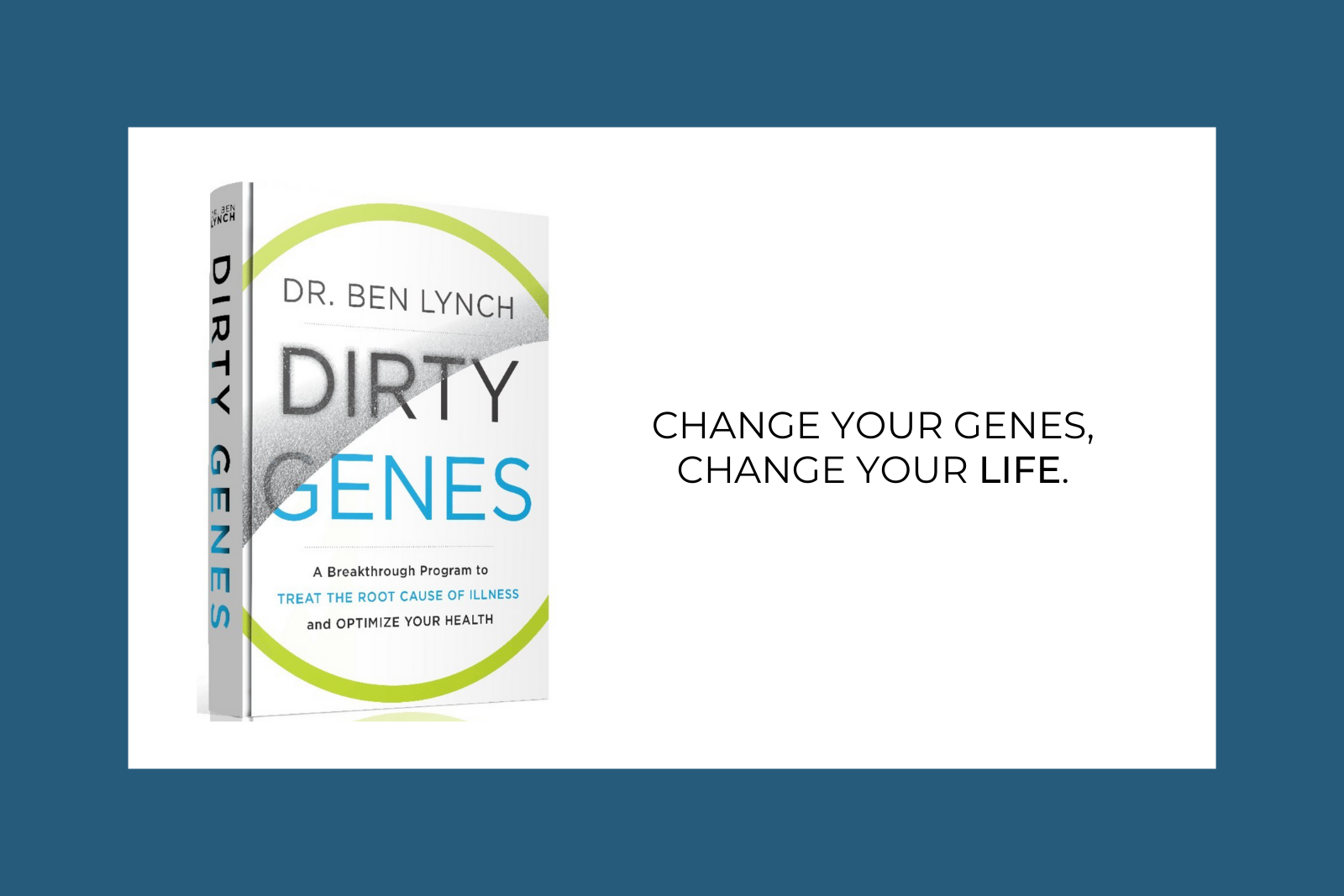
The Bottom Line
As epigenetics expert, Dr. Ben Lynch says, your genes are not written in stone. Your DNA is being written and rewritten constantly, and the nutrients you consume and the environment you put your body in have a major impact on how this works.
Now that you’ve met the Super Seven Genes, it’s time to find out which ones are acting dirty. Take the Dirty Genes assessment in Dr. Lynch’s book, Dirty Genes.For more information about your Super Seven Genes, download our free eBook here:
Click HERE to Download our FREE Super Seven eBook
References
- https://www.genome.gov/human-genome-project/Completion-FAQ
- https://ghr.nlm.nih.gov/gene/COMT
- The Diamine Oxidase Gene Is Associated with Hypersensitivity Response to Non-Steroidal Anti-Inflammatory Drugs - PMC (nih.gov)
- https://ghr.nlm.nih.gov/gene/MAOA
- https://www.ncbi.nlm.nih.gov/pmc/articles/PMC2745926/
- https://pubmed.ncbi.nlm.nih.gov/25366614-estrogen-induces-nitric-oxide-production-via-nitric-oxide-synthase-activation-in-endothelial-cells/
‡ This information is for educational purposes only. No product results are implied.

